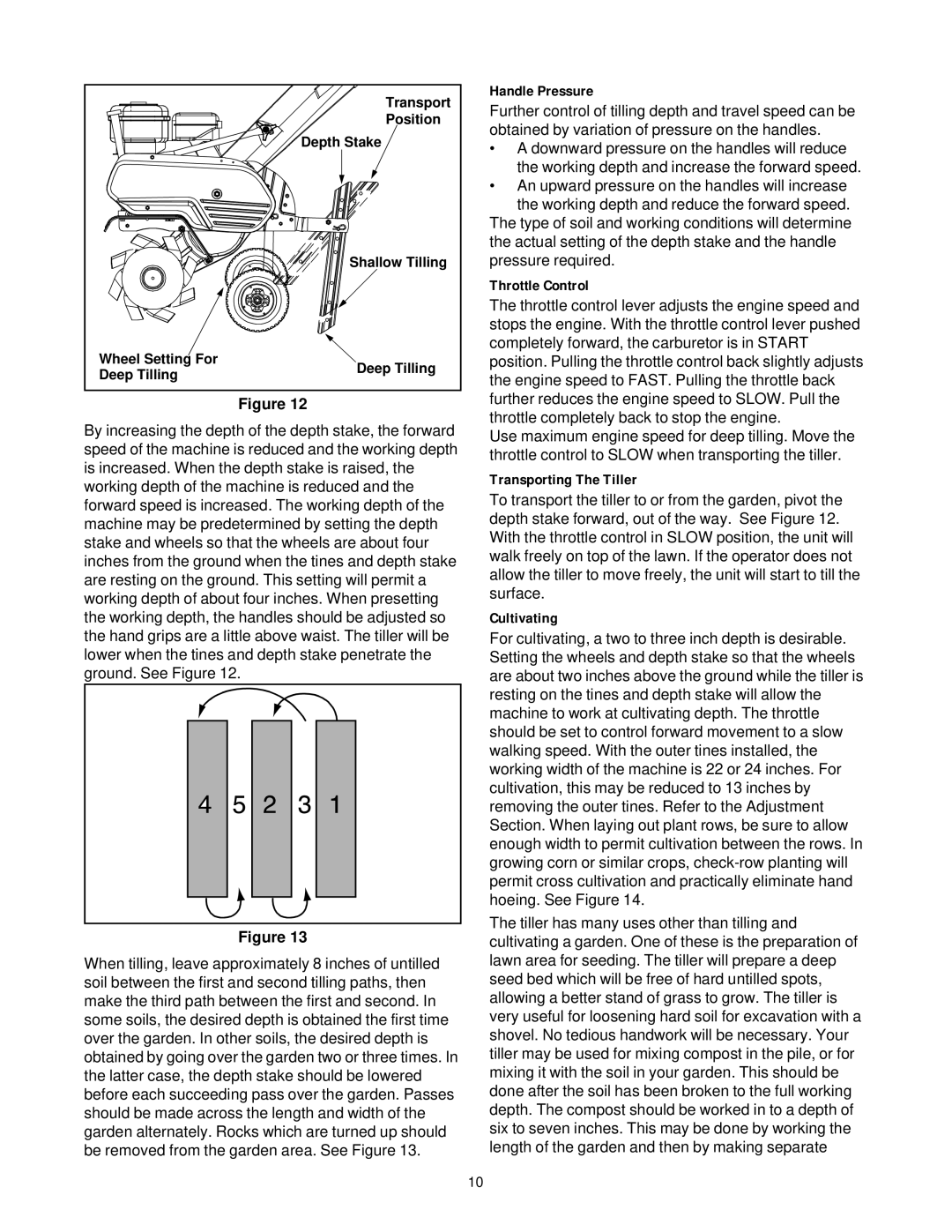
| Transport | |
| Position | |
| Depth Stake | |
| Shallow Tilling | |
Wheel Setting For | Deep Tilling | |
Deep Tilling | ||
|
Figure 12
By increasing the depth of the depth stake, the forward speed of the machine is reduced and the working depth is increased. When the depth stake is raised, the working depth of the machine is reduced and the forward speed is increased. The working depth of the machine may be predetermined by setting the depth stake and wheels so that the wheels are about four inches from the ground when the tines and depth stake are resting on the ground. This setting will permit a working depth of about four inches. When presetting the working depth, the handles should be adjusted so the hand grips are a little above waist. The tiller will be lower when the tines and depth stake penetrate the ground. See Figure 12.
Figure 13
When tilling, leave approximately 8 inches of untilled soil between the first and second tilling paths, then make the third path between the first and second. In some soils, the desired depth is obtained the first time over the garden. In other soils, the desired depth is obtained by going over the garden two or three times. In the latter case, the depth stake should be lowered before each succeeding pass over the garden. Passes should be made across the length and width of the garden alternately. Rocks which are turned up should be removed from the garden area. See Figure 13.
Handle Pressure
Further control of tilling depth and travel speed can be obtained by variation of pressure on the handles.
•A downward pressure on the handles will reduce the working depth and increase the forward speed.
•An upward pressure on the handles will increase the working depth and reduce the forward speed.
The type of soil and working conditions will determine the actual setting of the depth stake and the handle pressure required.
Throttle Control
The throttle control lever adjusts the engine speed and stops the engine. With the throttle control lever pushed completely forward, the carburetor is in START position. Pulling the throttle control back slightly adjusts the engine speed to FAST. Pulling the throttle back further reduces the engine speed to SLOW. Pull the throttle completely back to stop the engine.
Use maximum engine speed for deep tilling. Move the throttle control to SLOW when transporting the tiller.
Transporting The Tiller
To transport the tiller to or from the garden, pivot the depth stake forward, out of the way. See Figure 12. With the throttle control in SLOW position, the unit will walk freely on top of the lawn. If the operator does not allow the tiller to move freely, the unit will start to till the surface.
Cultivating
For cultivating, a two to three inch depth is desirable. Setting the wheels and depth stake so that the wheels are about two inches above the ground while the tiller is resting on the tines and depth stake will allow the machine to work at cultivating depth. The throttle should be set to control forward movement to a slow walking speed. With the outer tines installed, the working width of the machine is 22 or 24 inches. For cultivation, this may be reduced to 13 inches by removing the outer tines. Refer to the Adjustment Section. When laying out plant rows, be sure to allow enough width to permit cultivation between the rows. In growing corn or similar crops,
The tiller has many uses other than tilling and cultivating a garden. One of these is the preparation of lawn area for seeding. The tiller will prepare a deep seed bed which will be free of hard untilled spots, allowing a better stand of grass to grow. The tiller is very useful for loosening hard soil for excavation with a shovel. No tedious handwork will be necessary. Your tiller may be used for mixing compost in the pile, or for mixing it with the soil in your garden. This should be done after the soil has been broken to the full working depth. The compost should be worked in to a depth of six to seven inches. This may be done by working the length of the garden and then by making separate
10
